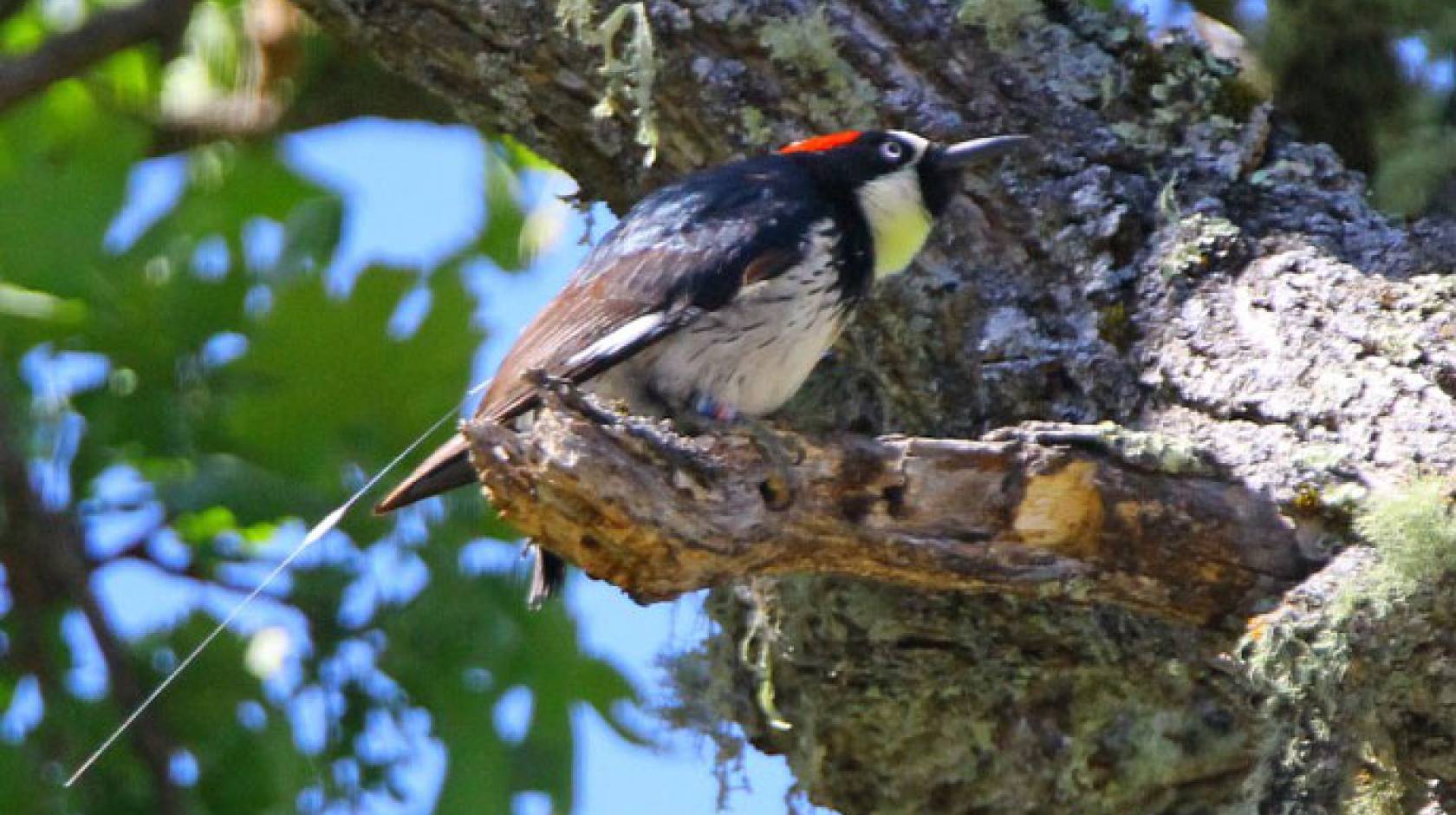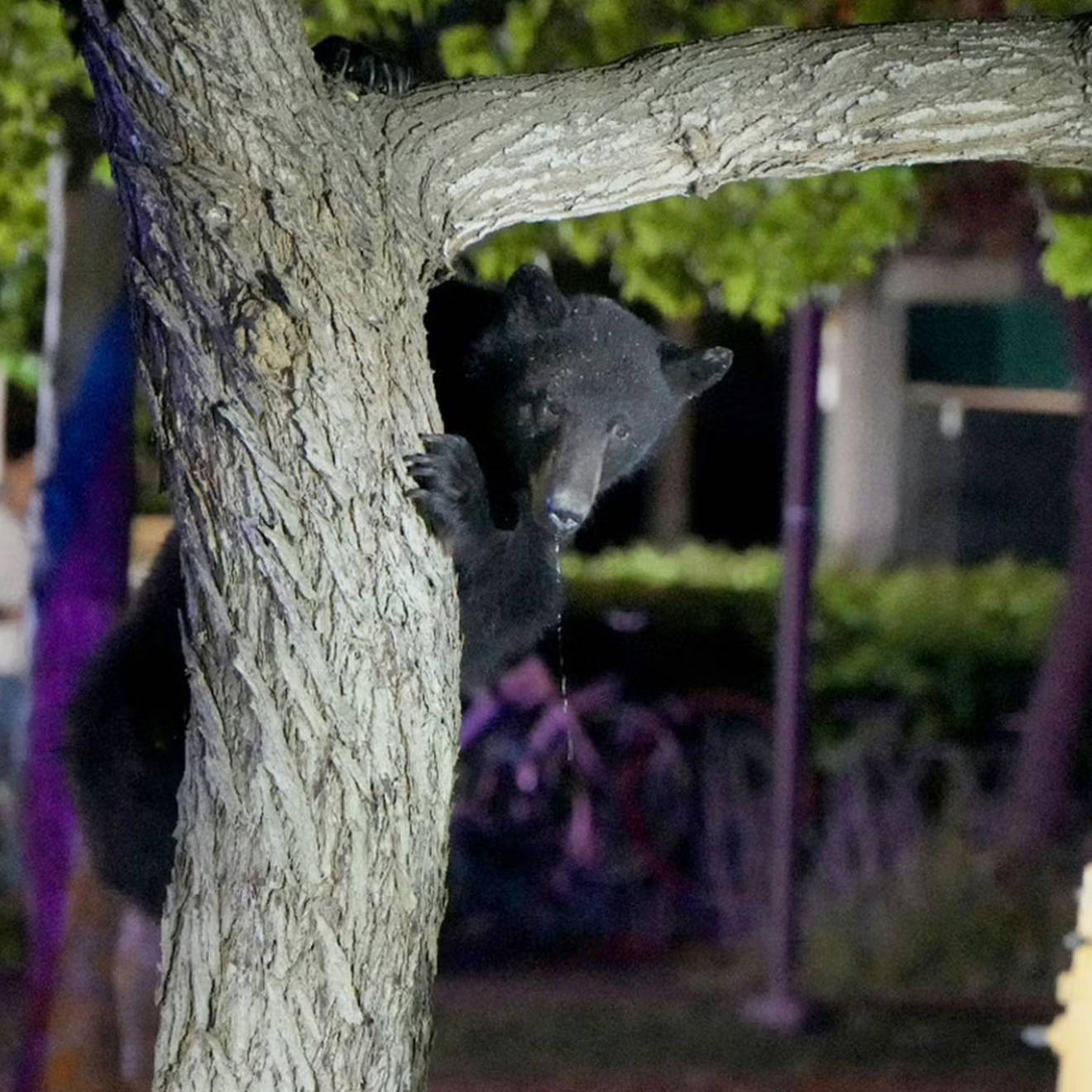Kathleen Wong, UC Natural Reserve System

Keeping tabs on wild birds has long been a low-tech proposition. While radio collars and satellite tags became standard for tracking big mammals, binoculars and notebooks have remained critical for following most twittering, flittering birds.
The holdup has been battery weight. To bleep the signals that reveal an animal’s location, transmitter tags require power. But for birds that weigh no more than a few pennies, even a watch battery can be too much to bear. Add in the need for recapture every few days to replace those batteries, and the dream of automated animal tracking becomes a logistical nightmare.
Now, new, lightweight tracking tags are making small animal tracking feasible. During field testing at the NRS’s Hastings Natural History Reservation, it’s given scientists a whole new perspective on the acorn woodpeckers (Melanerpes formicivorus) they’ve watched for decades. The birds turn out to be a lot more sly and strategic than researchers had long believed.
“You’d think that after almost 50 years of study, we’d know all there was to know about acorn woodpeckers. But this technology is helping us to answer questions we couldn’t answer before,” says Eric Walters, a biology professor at Old Dominion University, Virginia.
Woodpecker families are weird
These scarlet-capped birds are head-scratchers, all right. For starters, their family structure is among the most peculiar in the avian world. Several related birds of one sex (often sisters), typically breed with an unrelated set of several related birds of the opposite sex (often brothers).
Another puzzler surrounds the life choices of young woodpeckers. Where most fledglings leave the nest to found their own families, young “helper” woodies may linger at home for a decade.
“The question we had is, why? There must be some benefit to staying at home,” Walters says. “Do they spend their time at home helping to feed their siblings and store acorns? Or are they like teenagers in the basement watching TV all day and doing nothing?”
Game of Granaries

Credit: Kathleen M. Wong
Walters suspected the answer lies in a young woodpecker’s thirst for territory. Like the fictional nobles in "Game of Thrones," birds will do anything to conquer their own kingdom. Their goal is to secure a good granary tree, which houses the acorn stash critical to a woodpecker family’s survival.
A massive granary tree affords a woodpecker family plenty of advantages. They’re more likely to survive harsh winters, raise surviving chicks, and ensure the triumph of their own bloodlines.
Good granaries are tough to come by. It takes an age to build one — the hole for one acorn might take ten minutes to excavate, and large granaries may hold tens of thousands of acorns. Competition to secure the biggest granaries and their surrounding territory is fierce.
Gang wars
A granary goes up for grabs only after all breeders of one sex in a family group have died or left. When a breeding spot opens up, birds from other families battle over the succession.
Successful combatants don’t show up alone. Instead, groups of siblings from other territories duke it out.
“It’s like a gang war,” says graduate student Natasha Hagemeyer, who is studying woodpecker dispersal at Hastings with Walters.
Clashes may last for days, with foes hunting one another through the trees, grappling in midair, falling to the ground, and hammering one another with their powerful bills.
Grievous injuries aren’t uncommon. “One had a toenail torn out and bled profusely. Another got some of its wing feathers ripped away; it disappeared within a week,” Hagemeyer says. But the potential spoils — the chance to breed — are worth any cost.
Waiting in the wings
When a rare vacancy does open up, aspiring replacements are ready. “When we caught a breeding bird to band, other birds thinking it was gone would move in and start challenging for that territory within ten minutes,” Walters says.
How neighboring birds figured this out was a mystery. “We almost never see them off territory,” Hagemeyer says.
Previous studies done with radio transmitters indicated young birds do go on longer forays off their own family’s domain. “But when you radio track on foot with handheld antennas, you can only follow one bird at a time. To follow a set of siblings, you need a one-to-one ratio of people and birds. It rapidly becomes infeasible. And if an animal wants to be sneaky, like going into an enemy’s territory, you can spook them, making tracking just about impossible,” she says.
Tag testing

Credit: Rebecca Westwick
The solar powered tracking tags, which don’t require real-time monitoring, seemed tailor made for the problem. The size of a postage stamp, they consist of a silicon chip, a solar panel, and an antenna. Tags are attached to the woodpeckers via a backpack harness.
Each tag weighs half a gram — the same as a Tic Tac. That’s light for a 70 grams acorn woodpecker, and could even work for finer-boned birds such as swallows and warblers.
Pings from the tags are picked up by an antenna connected to a minicomputer. Walters and Hagemeyer placed these base stations next to woodpecker granaries.
When a tagged bird comes within 130 meters of a base station, its computer records the identity of the bird and the time of its arrival. Hagemeyer downloads the data from the computers every few weeks.
The wealth of new field data quickly turned into a flood, she says. “Over the first five months, we got more than 5 million tag detections. Computer programming is a major part of what I do now.”
With those data points, Hagemeyer is able to generate network diagrams indicating which birds associate with each other on the landscape. The resulting picture is of a bird with an astonishingly complex social life that includes dropping in on kin for friendly visits, foraying with siblings, and rallying the family to seize richer digs.
Refining the design

Credit: Vince Voegeli
The original system was developed by a team of engineers and biologists led by professor David Winkler of Cornell University, who did initial field tests on tree swallows.
Over the past several years, the Hastings crew has pioneered a number of improvements to the system. Some were inspired by the woodpeckers themselves. “We soon realized their long, powerful beaks could rip the antennas right off the original design. We went through several designs as the woodpeckers destroyed them,” says Hagemeyer.
The current incarnation is considerably more rugged. Some are still working after three solid years on a bird.
The base stations are also greener thanks to Hastings reserve director Vince Voegeli. “The old systems required eight high-end AAs every couple of weeks. We were throwing out buckets of batteries,” Voegeli says. He devised a way to power the base station’s computer with a solar panel wired to a rechargeable battery instead.
Growing up on a farm, plus years spent running a field station on a remote island in the Bahamas, gave Voegeli the necessary appetite for tinkering. “When you live in the middle of nowhere you can’t run down to Home Depot, so you learn to do things on your own,” he says. Down the road, he hopes to apply these new solar skills to take much of Hastings off the power grid.
A reserve asset
The tag system has worked so well that 48 base stations are now deployed across the reserve, each covering the territory of one woodpecker family.
The system could be a boon for other scientists as well. Already professor Janis Dickinson of the Cornell Lab of Ornithology wants to deploy the tags on the western bluebirds she’s long studied at the reserve.
A whole lotta spying going on

Credit: Vince Voegeli
The solar tag data has been a revelation to the woodpecker researchers. Not only has it demonstrated just how often the birds foray and where they travel, it’s revealed a decidedly sneaky side to woodpecker ways.
Rather than babysitting siblings and guarding the granary, many helpers spent up to 90 percent of their time outside of their own territory. “They’re not just wanting to spend time with mom and dad, but are actually spending a lot of time cruising the landscape looking for vacancies,” Walters says.
Hagemeyer has another term for them. “They’re a bunch of busybodies,” she says. “They’re much more connected and spend way more of their time traveling and keeping tabs on each other than we would ever have thought. We had no idea until these tags.”
The purpose of these forays is clearly spying, Hagemeyer says. “We monitor groups a lot, and only rarely catch sightings of birds that don’t belong there from other territories. They are not sitting on high perches, catching insects, or approaching the granary. It seems they’re hiding out in the periphery in dense vegetation.”
Hastings social networks

Credit: UC Natural Reserve System
This new information shows just how strategic young woodpeckers are with their time. They know they must follow one of two routes to breeding success. “You either help at home and look to inherit, or sleep at home but spend all your time out looking for a place to take over,” Hagemeyer says.
Birds don’t visit all territories equally, either. They are keenly attuned to levels of acorn wealth. “Both helpers and breeders direct their forays at high-quality territories with the biggest granaries. Those from low- and medium-quality territories go and look wistfully at high-quality territories,” she says. Birds also seem to make friendly visits to the territories of kin.
“She’s uncovering social networks for woodpeckers with reads from these tags,” Walters says.
A solar tag future
Walters and Hagemeyer plan to outfit all 250 or so woodpeckers that reside at Hastings with tags over the next few years, to augment the data from the 30 birds they’re tracking now. They already band all woodpecker hatchlings on the reserve; adding a tag takes just a few extra minutes.
The tags can transmit much more information than merely the identity of its wearer. For example, they could monitor blood oxygen levels and heartbeat rates, which correlate with exercise; and the angle of a bird’s body, which indicates whether it’s flying or perched.
Wilder still are the possibilities for long distance migration studies. One idea is to conscript large animals such as turkey vultures or deer as mobile detection stations. As the vulture or deer moves across the landscape, it can pick up pings from tagged animals nearby.
In the meantime, Hagemeyer is gleaning all the woodpecker insights she can from the big data delivered by the newfangled tags. “We’re really excited to have this system. It gives us a wealth of information that is simply impossible to get any other way.”

